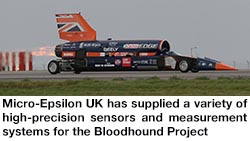First public run of Bloodhound SSC is a resounding success with the help of sensors from Micro-Epsilon UK
08/01/2018
Bloodhound SSC reached a major milestone in October 2017, as it made its first public run at the Aerohub at Cornwall Airport Newquay. However, the event was not just about driving the car successfully down the runway and showing it to spectators; it was also about testing the car and putting it through its paces, in particular testing that the hundreds of on-vehicle sensors were performing correctly under such extreme operating conditions.As a product sponsor of the Bloodhound SSC Project, Micro-Epsilon UK has supplied a variety of high-precision sensors and measurement systems for the project, which have been used throughout the testing and production stages.
 In 2014, for example, Micro-Epsilon UK supplied a variety of non-contact laser displacement sensors and an infrared thermal imaging camera for use in high-speed (up to 10,500 r/min) wheel-spin tests. The tests, which took place at Rolls-Royce’s test facility in Derby, were carried out on the first of Bloodhound’s four solid aluminium wheels. The wheel-spin test was the highest ever rotational speed recorded on the test-rig.
In 2014, for example, Micro-Epsilon UK supplied a variety of non-contact laser displacement sensors and an infrared thermal imaging camera for use in high-speed (up to 10,500 r/min) wheel-spin tests. The tests, which took place at Rolls-Royce’s test facility in Derby, were carried out on the first of Bloodhound’s four solid aluminium wheels. The wheel-spin test was the highest ever rotational speed recorded on the test-rig.The objective was to verify that the growth (expansion), temperature increase (due to air friction) and vibration of the wheel were within expected and safe limits, and whether these test results would closely match the Bloodhound Team’s own predictions using computer simulation and finite element analysis (FEA) software. For the tests, Micro-Epsilon UK supplied a total of 15 laser displacement sensors from its optoNCDT series, as well as a thermoIMAGER TIM 450 compact high-resolution infrared imaging camera.
The laser displacement sensors were set up on the test-rig to measure the radial and axial run-out of the aerospace-grade aluminium wheel as it rotated at speeds of up to 1100 mph (the wheels will travel at speeds of up to 1000 mph during the supersonic machine’s record breaking attempt). In addition, laser displacement sensors were also set up to measure the thermal expansion of the frame that runs across the top of the test-rig (ie for test-rig calibration purposes). Four optoNCDT 1402 laser sensors were mounted underneath the test-rig in a confined space to measure the run-out, alignment and any other movements of the test-rig, including the steel hub that the wheel is mounted to.
Micro-Epsilon also supplied its thermoIMAGER TIM 450 infrared imaging camera for the wheel-spin test. This compact high-resolution camera was located in a confined space underneath the test-rig to monitor the temperature of the entire wheel during the spin test.
During the test, the wheel was successfully spun to 10,429 r/min (174 revolutions per second). Test results were similar to the predictions that the Bloodhound engineers had calculated using their computer simulation software. The expansion of the wheel’s 902.6 mm diameter by
1.6 mm was as expected. So too was the ‘dishing’ of the wheel caused by a variation in expansion rates between the aluminium material of the wheel and the steel hub. According to the Bloodhound Team, the empirical data collected during the test will now be used to fine-tune the computer simulations, delivering an optimised wheel design.
In 2015, Micro-Epsilon UK also supplied non-contact laser displacement sensors for on-vehicle ride height tests. The tests were carried out at the Jaguar Land Rover Gaydon Centre in Warwickshire. Mounted to the chassis of a Jaguar XF test vehicle with the laser window pointing down towards the ground, the optoNCDT 1700 high-speed sensor accurately measured and monitored the ride height of the car. The sensor has enabled the Bloodhound SSC team to adjust the suspension characteristics in order to optimise the performance of the car. For the ride height tests, two optoNCDT 1700 laser displacement sensors were mounted side by side to an adapted tow bar at the rear of the Jaguar XF. As well as on-vehicle testing, Micro-Epsilon’s optoNCDT 1700 series of laser displacement sensors will also be used for the Bloodhound SSC record attempt itself.
www.micro-epsilon.co.uk